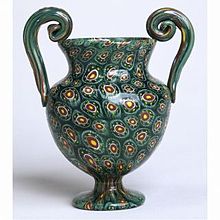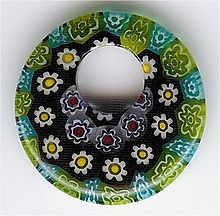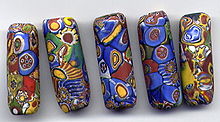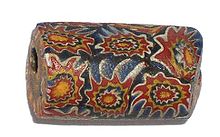- Millefiori
-
"Millefiore" redirects here. For the fictional Mafia family in the Reborn! series, see Millefiore Family.
 Murano Millefiori Pendant
Murano Millefiori PendantMillefiori is a glasswork technique which produces distinctive decorative patterns on glassware.
The term millefiori is a combination of the Italian words "mille" (thousand) and "fiori" (flowers)[1]. Apsley Pellatt (in his book "Curiosities of Glass Making") was the first to use the term "millefiori", which appeared in the Oxford Dictionary in 1849. The beads were called mosaic beads before then. While the use of this technique long precedes the term millefiori, it is now frequently associated with Venetian glassware.
More recently, the millefiori technique has been applied to polymer clays and other materials. Because polymer clay is quite pliable and does not need to be heated and reheated to fuse it, it is much easier to produce millefiori patterns than with glass[2].
Contents
History of Millefiori
The manufacture of mosaic beads can be traced to Ancient Roman, Phoenician and Alexandrian times. Canes, probably made in Italy, have been found as far away as 8th century archaeological sites in Ireland,[3] and millefiori was used in thin slices to brilliant effect in the early 7th century Anglo-Saxon jewellery from Sutton Hoo.
The technical knowledge for creating millefiori was lost by the eighteenth century, and the technique was not revived until the nineteenth century.[4] Within several years of the technique's rediscovery, factories in Italy, France and England were manufacturing millefiori canes.[4] They were often incorporated into fine glass art paperweights.
Until the 15th century, Murano glassmakers were only producing drawn Rosetta beads made from mould-made Rosetta canes. Rosetta beads are made by the layering of a variable number of layers of glass of various colors in a mould, and by pulling the soft glass from both ends until the cane has reached the desired thickness. It is then cut into short segments for further processing.[5]
 Murano Millefiori
Murano Millefiori
Creating Millefiori
The millefiori technique involves the production of glass canes or rods, known as murrine, with multicolored patterns which are viewable only from the cut ends of the cane.[5] A murrine rod is heated in a furnace, pulled until thin while still maintaining the cross section's design, and then cut into beads or discs when cooled.[5]
See also
- Mille-fleur, a French term used to refer to a background composed of small flowers
- Glass museums and galleries
- Venetian beads
References
- ^ "Millefiori Beads". http://www.dphjewelry.com/art-n0711-103.html.
- ^ "Millefiori technique in clay". http://www.artsncrafts-ideas.com/millefiori-fimo-clay.php.
- ^ Susan Youngs (ed), "The Work of Angels", Masterpieces of Celtic Metalwork, 6th-9th centuries AD, 1989, British Museum Press, London, ISBN 0714105546
- ^ a b "History of millefiori". http://www.museum.state.il.us/exhibits/barker/techniques/tech_millefiori.php.
- ^ a b c "History of the Murano Glass Pendant". http://www.fossilfly.com/Creating_a_Millefiore_Pendant.htm.
Glass forming techniques Commercial techniques Float glass process · Blowing and pressing (containers) · Extrusion / Drawing (fibers, glasswool) · Drawing (optical fibers) · Precision glass moulding · Overflow downdraw method · Pressing · Casting · Cutting · Flame polishing · Chemical polishing · Diamond turning · RollingArtistic and historic techniques Beadmaking · Blowing · Blown plate · Broad sheet · Caneworking · Crown glass · Cylinder blown sheet · Engraving · Etching · Fourcault process · Fusing · Lampworking · Machine drawn cylinder sheet · Millefiori · Polished plate · Slumping · Stained glass fusing · Stained glass productionSee also Beadwork Beads Aggry beads · Bead · Chevron bead · Glass beadmaking · Faturan · Hair pipe · Heishe · Kiffa beads · Love beads · Millefiori · Murano beads · Peranakan cut beads · Powder glass beads · Seed bead · Sequin · Trade beads · Wampum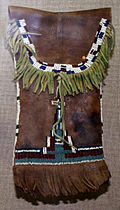
Tools and techniques Bead crochet · Bead embroidery · Bead stringing · Bead weaving · Brick stitch · Peyote stitch · Square stitchBead artists Richard Aitson · Marcus Amerman · Martha Berry · Chipeta · Juanita Growing Thunder Fogarty · Teri Greeves · Maude KeggRelated
Wikimedia Foundation. 2010.

